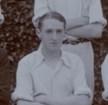
War Memorial
| Brigadier General John Cecil CURRIE (11446) DSO and Two Bars MC | |
|
4th Armoured Brigade Date of birth: 27th February 1898 Date of death: 26th June 1944 Killed in action aged 46 Buried at Bayeux War Cemetery Plot XV Row G Grave 12 |

|
| John Cecil Currie was born at Westerham, Kent on the 27th of February 1898 the only son of Brigadier General Arthur Cecil Currie CB CMG, Royal Artillery, and Amy (nee Haggard) Currie of "The Breaches", Westerham. He was educated at Hazelwood School until July 1910 where he was a member of the Choir. He was a member of the Cricket XI in 1909 and 1910 and was a member of the Football XI in 1909. The school magazine wrote the following on his 1909 cricket season: - "Later on will make a bat, at present rather disappointing. A useful change bowler and a good field." Of his 1910 cricket season they wrote: - "A fair all round performer, though he seldom seems able to reproduce in a match the ability, to which the practice games bear testimony." They wrote the following on his 1909 football season: - "(Back) - Has lengthened his kicking and made a great advance in the matter of "going straight"; but is a poor tackler, with no sound knowledge as yet of a back's duties." On leaving the school the magazine wrote of him: - "...also to our great regret migrates earlier than we had expected to the Junior School at Cheltenham. We hope to see him figuring in one of the Scholarship lists if he makes the most of his undoubted abilities." He went on to the Junior School at Cheltenham College where he was in Christowe House, leaving in 1914 for the Royal Military Academy, Woolwich. He was commissioned as a 2nd Lieutenant in the Royal Field Artillery in April 1915 and was appointed as Aide de Camp to his father at Royal Artillery Headquarters in France on the 11th of July 1915; he embarked for France on the same day at the age of 17. During the war he saw service in France and Iraq. He was wounded in January 1917 and was awarded the Military Cross in the King's Birthday Honours List of the 3rd of June 1918. He finished the war with A Battery, Royal Horse Artillery with the rank of Acting Major, a rank he relinquished on the 15th of February 1919 on ceasing to command a battery. He was married to Marianne Charlotte (nee Blackburn) on the 9th of December 1926 and they lived at Elmsworthy in Somerset. Between the wars he served at Gibraltar and in China. In October 1939 he went to France once more, as part of the British Expeditionary Force in command of L Battery, Royal Horse Artillery. Before the German invasion of Belgium he was placed in command of the 2nd Field Regiment, Royal Artillery and was evacuated from Dunkirk. On returning from France he formed a Mountain Artillery Regiment and took it to Palestine in the spring of 1941. On the 19th of September 1941 he was appointed as Officer Commanding 4th Royal Horse Artillery Regiment with the rank of Lieutenant Colonel and joined them in Egypt. He was awarded the Distinguished Service Order which was announced by the War Office on the 12th of February 1942 for his part in the Battle of Sidi Rezegh in November 1941. The recommendation for the award read as follows: - "Lt Col Currie has been commanding a mixed column during the operations 18th-24th Nov 1941. During this period he has displayed the most outstanding initiative, courage and determination. On the 22 Nov 1941 when a large scale German attack took place on the Sidi Rezegh position, Lt Col Currie personally took command of a Troop of guns, turned them about, and engaged enemy tanks at close range. On this occasion his courage and disregard for his personal safety was a wonderful example to the men of this Troop who, following his example, returned the fire of the enemy tanks and drove them off. On the 30 Nov, Col Currie was ordered to move around the enemy flank N.W. of Liffey, and engage enemy columns in that area. Col Currie took command of this operation himself and, moving forward into a very exposed position, was so able to direct the fire of his guns that large concentrations of enemy were scattered and heavy casualties to men and material inflicted. This result was entirely due to this officer's courage, initiative and excessive determination to carry out the tasks given to him. This determination of his has been a most outstanding feature and must be a wonderful example to all officers in his command." He was promoted to Acting Colonel on the 8th of February 1942. On the 22nd of April 1942 he was appointed as Commanding Officer of 9th Armoured Brigade, serving in North Africa. He played a key role in the victory at El Alamein where 9th Armoured Brigade was given the "suicidal" assignment of being the spearhead of the British breakout from Alamein. At the briefing before the attack General Sir Bernard Fryberg told Currie:- "We realise that for armour to attack a wall of guns sounds like another Balaclava; it is properly an infantry job. But there are no more infantry available, so our armour must do it". When Currie suggested that casualties could be as high as fifty percent, General Montgomery told him to expect one hundred percent casualties. At dawn on the 2nd of November 1942 9th Armoured began to move forward. Silhouetted against the early morning sky its tanks became an easy target for a batteries of German 88mm guns which were ranged on three sides who picked off tank after tank despite coming under nine British air attacks themselves. Of the 133 tanks which went into action 102 were lost leaving the battlefield covered by a pall of smoke and dust and littered with burning tanks, wrecked guns and dead crews. After the action Brigadier Gentry of the 6th New Zealand Brigade went ahead to survey the scene. On seeing John Currie asleep on a stretcher, he approached him saying, 'Sorry to wake you John, but I'd like to know where your tanks are?' Currie waved his hand at a group of tanks around him, replying "There they are.' Gentry was puzzled. 'I don't mean your headquarters tanks, I mean your armoured regiments. Where are they?" Currie waved his arm and again replied, "There are my armoured regiments, Bill". By drawing two enemy panzer divisions against them 9th Armoured Brigade's attack had created a gap in the German line further to the south west through which Montgomery poured his remaining tanks, pushing them through the enemy rear areas and supply lines and won the battle. Currie's brigade had lost 102 tanks with 31 officers and 198 other ranks killed wounded or missing. General Montgomery wrote:- "If the British armour owed any debt to the infantry of the Eighth Army, the debt was paid on November 2nd by 9th Armoured Brigade in heroism and blood." For his part in the Battle of El Alamein, John Currie was awarded a bar to his Distinguished Service Order which was announced by the War Office on the 28th of January 1943. The citation for the award read as follows: - "For most distinguished services during the heavy fighting from 23rd October to 4th November 1942, at El Alamein. Brigadier Currie commanded his Armoured Brigade with great determination and personal courage during three attacks and in the ensuing fighting. It was largely due to his courageous leadership and example on the morning of 2nd November that despite heavy casualties his tanks made the breach in the enemy gun line which led up to the breakthrough of our armoured forces." He was promoted to Brigadier and was appointed as Commanding Officer of 4th Armoured Brigade from the 27th of February 1943 during which time they fought at the Mareth Line in Tunisia in March 1943. On the 10th of July 1943 John Currie led 4th Armoured Brigade ashore during the invasion of Sicily and on the 17th of August 1943, after five weeks of heavy fighting, 4th Armoured Brigade was the first Allied unit to enter the city of Messina. On the 21st of September 1943 the brigade received orders for the invasion of Italy. After crossing separately from Sicily the Brigade was reunited at Taranto on the 29th of September. His Brigade captured the main enemy position on a ridge to the west of the River Sangro in November and December 1943 for which he was awarded a second bar to his Distinguished Service Order, announced by the War Office on the 9th of March 1944. The citation for his award read as follows: - "Between 29 Nov and 1 Dec 43 this officer was commanding 4 Armd Bde. during the operations for the capture of the enemy main position on ridge west of R. Sangro. This difficult operation was successfully carried out mainly due to the outstanding leadership, drive and determination of this officer. Throughout the operation he handled his Brigade most skillfully and was constantly in the forefront of the battle directing operations. His cheerfulness, disregard of danger and outstanding powers of leadership were an inspiration to his troops and undoubtedly largely contributed to the success of the operation." John Currie left for England on the 30th of December 1943 to become Brigadier, Royal Armoured Corps to the 1st Canadian Army and in January 1944 4th Armoured Brigade sailed for the UK. On the 16th of March 1944 he returned to command 4th Armoured Brigade in preparation for the Normandy landings. They began landing on Sword Beach on the morning of the 7th of June 1944. On the 26th of June 1944 he was walking to his tank, having just given out his orders to his officers, when he was killed by shellfire near the level crossing to the south of Brettville. He is commemorated on a brass plaque at St Mary's Church, Westerham and on the war memorials at Westerham and at Cheltenham College. |
|
 | |
| Went on to Cheltenham College |
Back